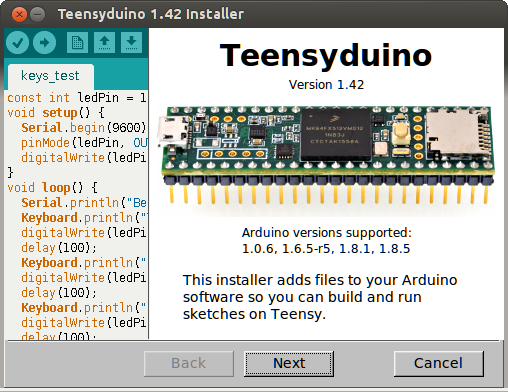Today PJRC is releasing Teensyduino version 1.42.
Here’s a detailed look at 1.42’s many new features and improvements.
I’d like to thank everyone who contributed & beta tested, especially Defragster!
The 1.42 installers are available now at the downloads page.
Arduino IDE Ports Menu & Serial Monitor
Since 2009 Teensy has supported non-Serial USB types (selected in the Tools > USB Type menu), but Arduino’s Ports menu has worked only with Serial devices. 1.42 extends the Ports menu with a new “Teensy” section capable of showing every USB type Teensy implements.
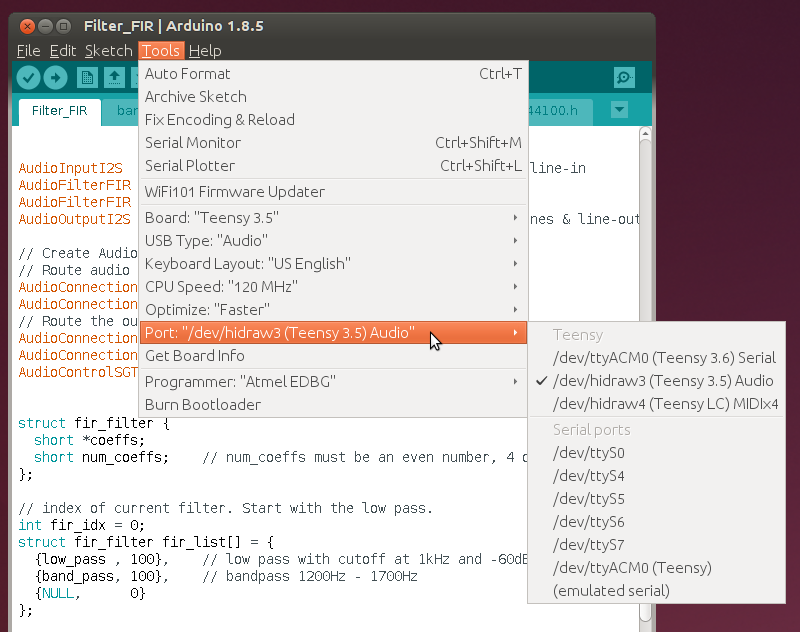
In this screenshot, 3 Teensy boards are connected, but only 1 is programmed to be Serial.
Teensyduino’s non-Serial modes include a HID interface to emulate serial, so you can still use Serial.print() to the Arduino Serial Monitor. Arduino’s “Serial ports” list is still present, where you would select “(emulated serial)” to use those other boards. The new “Teensy” ports list allows you clearly see which boards are really connected and to precisely choose the one you want.
Selections from this new Teensy Ports list are based on the physical USB port, plus any USB hubs. This info is shown in the lower right corner.

Here “usb2/2-1/2-1.2/2-1.2.2” is a Linux syntax meaning port 2 of a hub plugged into port 1 of the 2nd USB controller. Similar codes are used on Windows and Macintosh. These physical location codes allow Arduino to target exactly the board you’ve selected, even when it changes USB type.
Physical location allows Teensy auto-reboot to know exactly which Teensy you wish to upload. Previously (and still if you don’t select from the Teensy ports list) attempting to reboot required searching and trying to reboot whatever boards were found. If your Teensy isn’t responding to USB (interrupts disabled, deep sleep, etc) the auto-reboot process won’t search for other boards. It ends quickly. Of course no software on a PC or Mac can get your Teensy to report if it’s not communicating on the USB, which is why every Teensy is made with a button to force entering programming mode.
When you open the Arduino Serial Monitor with a board selected in the Teensy Ports list, a special version of the serial monitor customized to Teensy is used.
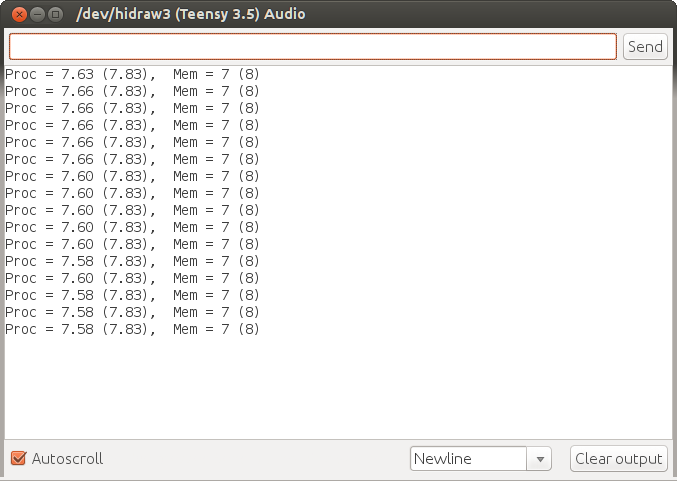
You can easily tell it apart from the normal serial monitor because it lacks the baud rate drop-down selection. Teensy USB always communicates at full USB speed, not the serial baud rate.
This new serial monitor has many features you can’t easily see. If you unplug your Teensy while it’s open, the USB disconnect is automatically detected. Likewise, reconnecting (on the same physical USB port) is automatically detected. Access to the hardware is done by a native “teensy_serialmon” helper program, rather than a Java serial library, which is meant to solve rare but difficult communication problems some people encounter.
If you want to use the old way, via the Java serial library, just select from the “Serial ports” part of the Ports menu. Look for the baud rate drop-down list to confirm you’re using the traditional serial monitor.
256K RAM Usable on Teensy 3.5
Some NXP/Freescale’s documentation for the MK64FX512 chip used on Teensy 3.5 says 192K of RAM. Other documentation says 256K. We have recently confirmed all these chips really do have 256K RAM.

Teensyduino 1.42 enables access to all 256K, except the last 8 bytes. Teensy Loader looks at the initial stack address to deduce which board you selected when compiling. Future versions may improve how the intended board is communicated. With 1.42, you get to 65528 more bytes of RAM for variables on Teensy 3.5.
USB Touchscreen Emulation
Many modern PCs have touchscreens, which is distinctly different then simply a mouse, because they can track the position of up to 10 fingers.
Starting with 1.42, Teensy can emulate a 10-finger tracking touchscreen. This quick video demo shows how it works.
After installing 1.42, click File > Examples > Teensy > USB_Touchscreen > TenFingerCircle to open the example used in this video.
Windows, Linux and some Android systems support multi-touch screens. Unfortunately no Apple Macintosh computers recognize USB multi-touch devices yet.
Audio Library New Features
Many great new features have been added to the Teensy Audio Library for 1.42. For this article I had wanted to shoot video demos, but the time required would mean holding up the 1.42 release. For now, here’s a quick summary with photos. I hope to bring you another detailed article next week with more details.
Audio: FreeVerb
FreeVerb was added, in both mono and stereo. It implements the high quality reverb algorithm as published by “Jezar” at Dreamport. FreeVerb’s quality is better than the reverb effect contributed a couple years ago by Joao Rossi FIlho. However, it uses more memory. The stereo FreeVerb requires Teensy 3.5 or 3.6, due to RAM usage.
FreeVerb has 2 tunable parameters for “room size” and “damping” to give you control over the effect. Of course, you can also add a mixer using the FreeVerb “wet” output with the original “dry” signal to tune how strongly the reverb effect is heard.
Audio: Granular Pitch Shift & Freeze
John-Mike of Bleep Labs contributed a granular processing effect. In the freeze mode it repeatedly replays a short segment of the sound you recently heard.
Pitch shift mode captures grains continuously and plays them back windows overlapping, interpolated to a different speed. When the parameters are set well, it results in a pretty good real-time pitch shift. Of course you can also set the parameters not-so-well if you wish to hear a very grainy output!
Audio: Waveforms
The generic waveform synthesis was greatly improve for 1.42, inspired by Bleep Labs, though in the end new code was written.
Variable Triangle has been added to the waveform synthesis, which allows you to change continuously from a sawtooth to triangle.
A long-standing bug with the phase(angle) function has been fixed in 1.42. You can now create 2 or more waveforms and control their relative phase shift. Of course all of the waveforms work down to nearly zero, so any can be used as low frequency oscillators (LFOs) to control or sequence effects or other synthesis, now with full control over relative phase timing.
A new modulated waveform synthesis object has also been added.
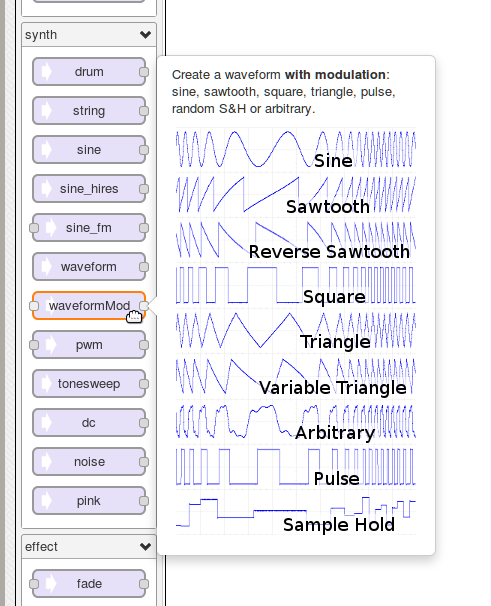
Previously only Sine_FM offered modulation. It was limited to one octave of frequency change, and the modulating signal varied the waveform period, which isn’t the proper “volt per octave” model.
The new waveform modulation allows you modulate the frequency of any of the 9 waveforms. Up to 12 octaves are available (the range is configurable), allowing you to modulate even a sub-sonic LFO all the way up to the top of human hearing range! The modulating signal uses proper exponential “volt per octave” scaling.
You can also configure the modulation to affect the waveform phase, for 8 of the 9 waveforms. The amount of phase shifting is also configurable, up to 9000 degrees (±25 full waveform cycles).
Waveform modulation also has a 2nd input, to allow any signal to modulate the Pulse duty cycle and Variable Triangle waveform shape.
Audio: Pulse Density Modulated (PDM) Input
Some very low cost microphones have a special 1-wire pulse density output signal, which must be low-pass filtered to recover the audio signal.
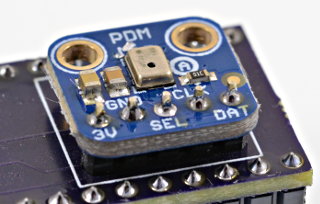
Teensy now supports these PDM signals. The low-pass filter is implemented as a single 512-tap FIR filter, which should have much better passband performance than the Cascaded Integrator Comb (CIC) filters typically used. But this does come at a computation cost, approximately 39% CPU usage when running Teensy at 96 MHz.
Audio: Other Improvements
Support for the WM8731 codec chip has been improved, with the ability to properly select between its microphone vs line input.
The envelope effect now offers status functions to tell if it’s active, and whether its sustain period as ended. When you use multiple envelopes to create (polyphonic) notes from oscillators or continuous other sound sources, these can help you better select which envelope is not currently “busy” to avoid truncating in-progress sounds.
The WAV file player and wav2sketch utility have been updated to handle unusual WAV files containing junk sections or other metadata before the format section. Now you can use these WAV files without having to convert them.
A simple “amp” object has been added, meant for switch signals, or amplifying or attenuating.
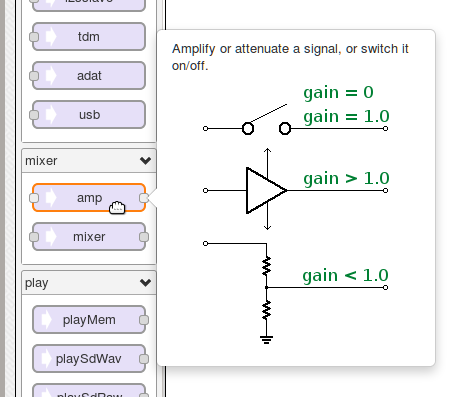
While this functionality has long been available by using only 1 channel of a mixer, consistent feedback from users has shown that placing a mixer into a graphical design simply does not feel right. Of course, the amp implements the cases of gain=0 and gain=1.0 by skipping all the math for efficient switching of signals.
Updates have also been made to audio library documentation in the design tool (right side panel). As the audio library continue to grow, documenting its many features well is becoming ever more important.
Compile Speedup
1.42 has changes to speed up fully recompiling your project. When Arduino prints “Build options changed, rebuilding all”, you’ll still have to wait, but hopefully not nearly as long.
The main improvement comes from removing “#include <algorithm> from wiring.h”. Version 1.41 brought a greatly improved map() function which automatically detects if the variable you’re translating is an integer or floating point number. This magic depends on C++14 features, so wiring.h had this and other includes added.
It turns out nearly all of the extra compile time is due to that one #include <algorithm> header. It has been removed, and map() still works, still automatically detecting integer versus floating point.
1.42 also changes the build process to use a pre-compiled header for Arduino.h (which in turn includes wiring.h). This offers some additional speed improvement, but only about a 20% reduction for most programs.
Teensy Loader Improvements
Teensy Loader has a little-known feature to show you detailed information. Few people know of this because it’s hidden in a place nobody would look, the Help menu.
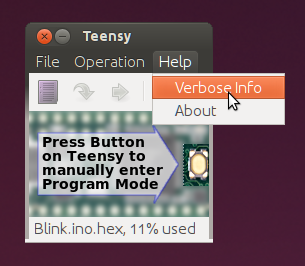
The Verbose Information window now shows events from the helper programs Teensyduino uses from Arduino, as well as the events from within Teensy Loader itself.
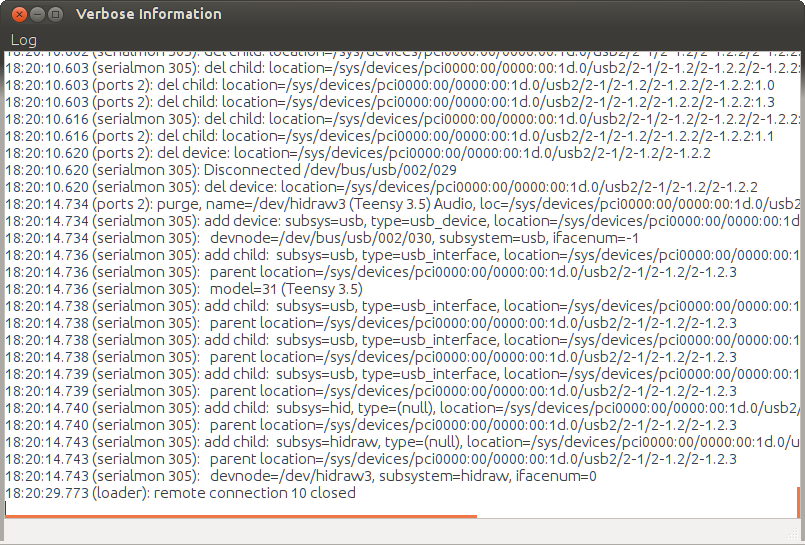
The events are now timestamped with millisecond resolution. Normally this level of detailed logging isn’t needed, but when “strange” USB problems occur, a log of all the events from every software component can really help.
Teensy Loader has only a few dialog boxes. The most important ones, alerting you to problems like the wrong board, have long been non-modal to prevent blocking event logging and responding to Arduino. Help > About and File > Open are also non-modal, completely eliminating modal behavior.
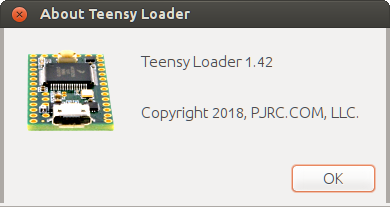
Teensy Loader’s internal graphics handling and memory management were improved.
Miscellaneous Improvements and Fixes
USB Host support on Teensy 3.6 received small improvements. KurtE updated the Joystick support. A bug impacting certain hubs was also fixed.
The Serial boolean, used to check if the Arduino Serial Monitor is open, has been improved.
Teensy’s support for X-Plane flight simulator received a fix to FlightSimFloat on Teensy 3.5 and 3.6. The Flightsim+Joystick USB type was also updated, fixing a problem where it would not be recognized by the TeensyControls X-plane plugin
A small speedup to analogWrite for DAC pins was made.
The startup delay in Teensyduino’s initialization code was reduced from 400 to 300 ms, and changes were made to begin USB enumeration sooner. While instant startup might seem highly desirable, too-fast startup tends to cause compatibility issues with many Arduino libraries, which do not properly wait for external hardware – because all Arduino boards have slow startup.
A bug in DMAChannel.h transferSize() affecting Teensy LC was fixed.
USB Keyboard KEY_MEDIA_RANDOM_PLAY was fixed.
EthernetClient received a fix for forced connection close.
A subtle timing problem in OctoWS2811 affecting Teensy 3.5 was fixed.
When compiling on 32 bit Teensy boards, “narrowing conversion” is now treated as only a compiler warning, not an error, as has always been done on 8 bit boards. This allows some poorly written libraries to “just work” even though their code is a bit sloppy.
Ethernet.init(cspin) is now documented in all the Ethernet examples, and on the Ethernet page. This function is an Adafruit extension which PJRC adopted for Teensy’s version of the Ethernet library, but until now it wasn’t actually documented.
Libraries ADC, OneWire, PS2Keyboard, SerialFlash, Time, TimeAlarms (included in the Teensyduino installer) were updated.
The Macintosh version is now 64 bits software, as required by the newest High Sierra and future versions of MacOS.
Arduino Versions Supported
Support for Arduino 1.8.2 and 1.8.3 and 1.8.4 has been dropped. The new ports menu and serial monitor are only implemented on Arduino 1.8.5.
Teensyduino is continuing to support 3 old versions of Arduino. Arduino 1.8.1 was the last version before major changes in Arduino’s “arduino-builder” program. Arduuino 1.6.5-r5 was the last version before “arduino-builder”, where the entire build process is controlled by the Java code in the Arduino IDE. Arduino 1.0.6 was the last version of the very old 1.0 series.
Arduino appears to have entered a period of slower release. Through 2016-2017, Arduino made 12 stable releases. Since releasing 1.8.5 in September 2017, they started a 1.9 beta but haven’t made any non-beta releases. If this trend continue, we may explore supporting specific 1.9 beta versions.
At the recent San Mateo Maker Faire, Massimo Banzi announced a developer summit. PJRC will be participating. My personal hope is we can move the entire Arduino ecosystem forward with contributions like EventResponder. I plan to write more detailed articles about this effort as it develops.
Recently work was also done to support Linux 64 ARM (Aarch64), testing on nVidia Jetson TX2. While Aarch64 support is still considered “experimental” and not part of the stable 1.42 release, if you’re interested in running on Linux 64 bit ARM, please see the last 1.42 beta for an Aarch64 build that’s essentially the same as this 1.42 release.
